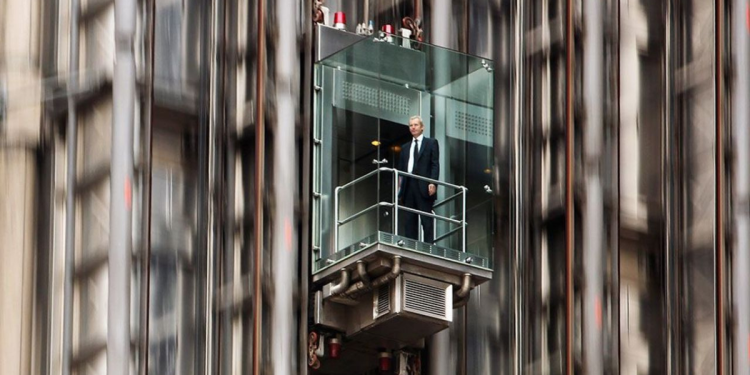Behind the din and flurry of the industrial logistics sector, the parcels you see move from truck to warehouse to vertical storage are just the last step in a long ladder of automation. Beneath that movement lies an engineered grid of systems designed with something in common – creating fluidity. Three oft-underappreciated heroes among them are usually out of public consciousness but cannot be substituted for ensuring the pace of cargo and commercial infrastructures- both, the elevator, the overhead doors, and the dock levelers. Once simple mechanical devices, they are now the marriage between automation, the physics of safety, predictive maintenance, and industrial design.
Industrial Elevation in the Age of Precision
While we associate the elevator with office skyscrapers and apartment buildings, the freight elevator ranks among the oldest cargo logistics workhorses-modern industrial elevators are light years away from their precursors-they are digitally synchronised, precision engineered, and becoming even more intelligent. Present-day cargo elevators are engineered not just by gross mass, but by usage rate and integration.
Though warehouses have verticalised more and more, even amidst dense urban logistics hubs with extremely limited space – the functionality of the elevator has evolved from convenience options to requirements. These new layouts have regenerative braking, power feed forward circuits, and level sensors that adjust lift speeds by contents, such that neither time nor power is consumed.
Plus, the technology is mind-blowing. Gearless traction systems with their longer life spans and minimal oil usage are becoming ever more prevalent due to environmental issues and economics. Systemwide connections between elevators and stock-taking systems are now linked without the need for human intervention. Scanning occurs on a pallet that is afforded an assigned location and is automatically delivered to the correct elevator shaft. Sensors are continually reading for motor temp, cable wear, and vibration anomalies and warning before failures, with their diagnostics appearing on the tablets of technicians.
Overhead Doors as Operational Interfaces
Whereas the vertical plane’s arteries are the elevators, overhead doors are gates that control transit between interior activity and the external environment. Once mechanical swinging doors with chains and springs, these doors have evolved into something much more sophisticated: systems that coordinate energy efficiency, control of contamination, security, and traffic control at one time.
Today’s advanced overhead doors suitable for industrial usage have advanced features like multi-level insulating, high-speed roll-up options, and programmable logic controls (PLC). Data-driven environmental thermal image sensors take into consideration door closing or opening and are useful for reducing heat gain/loss and improving energy profiles. In facilities like food logistics or pharmaceuticals, the overhead doors are part of contamination control systems with UV sterilisers and air curtains for clean room maintenance despite busy schedules for deliveries.
Maintenance has kept pace as well. Smart rollers track cycles and alert facilities when torsion springs or tracks are near their fatigue limits. Barrier protection systems are no longer simply reliant upon straightforward pressure sensors, but use LIDAR and infrared arrays to scan the clearance zone before operation. These technologies are more than window dressing, accident potential, downtime, and repairs are reduced, with more compliance with workplace safety specifications. Overhead doors, inert barriers once, are active facilities themselves, dynamic participants in everyday operations, just as integral to facilities traffic flow are the machine tools within.
Dock Levelers – The Ground-Level Genius of Freight Transfer
It’s impossible to overstate just how important dock levers are to the logistics landscape. These directly offset what nature and trucks won’t: variability with truck bed heights, uneven loading surfaces, and the need for smooth, quick goods transfer.
There are new technologies for dock levelers that have made them safer, swifter, and more ergonomic than ever. Hydraulic systems now dominate, with their smooth operation and minimised physical stresses over manual spring systems. Air-powered types are becoming popular at high-humidity or washdown facilities by having fewer moving metal parts that are susceptible to rusting or corroding. High-end types have control panels that are WMS-compatible, and they control not just when the leveler descends, but how it descends depending on the nature of the load and truck dimensions.
RFID truck tags and Internet-of-Things (IoT)-connected levelers are even capable of preparing a dock station for an arrival schedule, in raising the leveler, removing restraints, and opening dock doors independently. The impact? Fewer accidents, less loading delays, a more synchronised interaction between truck and warehouse.
The Quiet Force Behind Logistics
The Dock Levelers, overhead doors, and the elevator might never experience their time in the spotlight. They won’t be the focal point of glamorous product launches or viral tech reels. But they are the hidden architecture supporting each timely delivery, each streamlined warehouse operation, and each secure cargo transfer. Their evolution, from cranked systems to smart, predictive systems, mirrors the broader industrial movement toward automation, yes, but smart automation.
They liberate logistics personnel from the grind between plan and firefight, reduce the opportunity for costly errors, and enable modern commerce at scale and pace, yet barely even remarked upon. To the untrained eye, they’re just infrastructures. To logistics experts, they’re the silent facilitators of motion, and in an industry built entirely upon motion, that’s everything.








